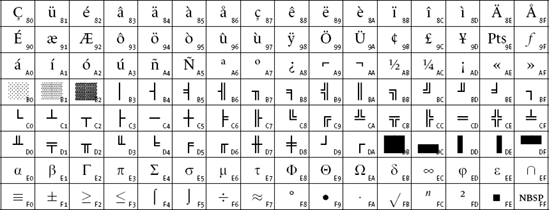1.7. Microsoft's code pages
The term codepage for "encoding" was oined by Microsoft. As the DOS system, for example, was console-based, we find in the DOS code pages a set of graphical symbols used to draw user interfaces through the simple arrangement of straight segments, corners, crosses, etc. There are even lattices of pixels that simulate various shades of gray.
In the US, the most commonly used DOS code pages were 437 ("United States") and 850 ("Multilingual"). In both cases, 128-position extensions to ASCII were made (the entire upper half of the table). Here is the part of the table beyond ASCII for code page 437, entitled "MS-DOS Latin US":

This code page is a real mixed bag: a few accented letters (there is an 'É' but no 'È'...), a handful of currency symbols, some punctuation marks, three rows of building blocks for drawing user interfaces, and a number of mathematical symbols, including a small range of Greek letters. One startling fact: the author does not know whether the character in position xE1 is a Greek beta 'β' or a German eszett 'ß'. Its location between alpha and gamma suggests that it is a beta, but at the same time the presence of the German letters 'ä', 'ö', and 'ü' implies that this encoding should logically include an 'ß;'. Could it be that the same character was supposed to serve for both? If so, depending on the font, we would have had aberrations ...
Get Fonts & Encodings now with the O’Reilly learning platform.
O’Reilly members experience books, live events, courses curated by job role, and more from O’Reilly and nearly 200 top publishers.

